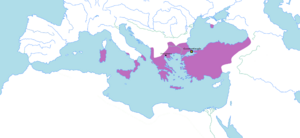Nikephoros I facts for kids
Quick facts for kids Nikephoros I |
|
|---|---|
| Emperor of the Romans | |

Gold solidus of Nikephoros I, marked: niciforos basile(us)
|
|
| Byzantine emperor | |
| Reign | 31 October 802 – 26 July 811 |
| Predecessor | Irene |
| Successor | Staurakios |
| Born | 750 |
| Died | 26 July 811 (aged 60–61) Battle of Pliska, Pliska |
| Spouse | Unknown |
| Issue |
|
| Dynasty | Nikephorian |
| Religion | Eastern Orthodox |
Nikephoros I (born around 750 – died July 26, 811) was a Byzantine emperor. He ruled from 802 to 811. Before becoming emperor, he was a high-ranking finance official. He was known as Logothetes tou genikou, which means "general logothete" or finance minister.
Nikephoros took the throne after overthrowing Empress Irene. During his time as emperor, he led armies against both Arab and Bulgarian forces. He died in battle while leading an invasion into Bulgaria. This happened at the Battle of Pliska.
Contents
Who Was Emperor Nikephoros I?
Nikephoros I was a powerful leader in the Byzantine Empire. He started his career as a finance minister. This was under Empress Irene. He then became emperor himself in 802.
Some old writings say Nikephoros might have had Arab family roots. However, Byzantine records do not clearly state this. Historians still discuss where his family came from.
How Nikephoros Became Emperor
Nikephoros was a respected official. He was known as a patrician from a place called Seleucia Sidera. Empress Irene had made him her chief finance minister.
He became involved in a power struggle at court. This led to Empress Irene being removed from power. With help from others, Nikephoros became emperor on October 31, 802. In 803, he made his son Staurakios a co-emperor. This meant Staurakios would share some power.
Ruling the Byzantine Empire
Emperor Nikephoros worked hard to make the Byzantine Empire stronger. He reorganized the government and tried to secure the empire's borders.
He created new administrative areas called themes. These were in the Balkans. He also moved Greek people from Anatolia to live in these new areas.
Managing Money and Taxes
To pay for his growing army, Nikephoros managed the empire's money very strictly. This made some people unhappy. He raised taxes and tried to control the church more. This caused problems with religious leaders.
Even though he appointed a new patriarch (a top church leader) who supported icons, some church historians wrote negatively about him.
Dealing with Rebellions
Nikephoros faced some challenges during his rule. One general, Bardanes Tourkos, led a rebellion in 803. Some people thought this was because of how Nikephoros handled army pay.
Nikephoros secretly talked with two of Bardanes's supporters. These generals convinced the rebel army to stop fighting. Bardanes was captured and sent to a monastery. Another plot against Nikephoros also failed.
Wars and Foreign Relations
Nikephoros had to deal with other powerful empires. He made a treaty with Charlemagne, the leader of the Franks. This treaty was called the "Pax Nicephori" in 803.
However, Nikephoros did not accept Charlemagne as an emperor. This led to a war over Venice between 806 and 810. The conflict was settled after Nikephoros's death. Venice and other areas went to the Eastern (Byzantine) Empire.
Fighting the Arabs
Nikephoros stopped paying a tribute that Empress Irene had agreed to pay to the Arab caliph Hārūn al-Rashīd. This started a war with the Arabs.
In 805, Nikephoros's army suffered a big defeat at the Battle of Krasos. In 806, a very large Muslim army invaded the empire. Nikephoros could not defeat them. He agreed to pay a large sum of money and an annual tribute for peace.
After Hārūn al-Rashīd died in 809, the Arab empire faced its own problems. This allowed Nikephoros to focus on another threat: the Bulgarians.
Conflict with Bulgaria
The Bulgarian leader, Khan Krum, was a growing threat. He had taken over the city of Serdica (modern-day Sofia).
In 811, Nikephoros led his army into Bulgaria. He won two battles against Krum. He also attacked and damaged the Bulgarian capital, Pliska. Some historical accounts describe his actions during this invasion as very harsh.
The Final Battle
As Nikephoros's army was leaving Bulgaria, they were ambushed. This happened in the Varbishki mountain passes. The Bulgarian army, led by Khan Krum, attacked them.
The Byzantine army was completely defeated in this battle. It is known as the Battle of Pliska. Emperor Nikephoros I was killed in the fighting on July 26, 811. His body was treated with extreme disrespect by the Bulgarians.
Family Life
Nikephoros I had at least two children with his wife, whose name is not known:
- Staurakios: He became emperor after his father.
- Prokopia: She married Michael I Rangabe, who also became emperor later.
See also
 In Spanish: Nicéforo I para niños
In Spanish: Nicéforo I para niños
|
Nikephoros I
Nikephorian dynasty
Born: 8th century Died: 26 July 811 |
||
| Regnal titles | ||
|---|---|---|
| Preceded by Irene |
Byzantine emperor 802–811 |
Succeeded by Staurakios |
| Political offices | ||
| Preceded by Constantine VI in 782, then lapsed |
Roman consul 803 |
Succeeded by Lapsed, Leo V in 814 |



